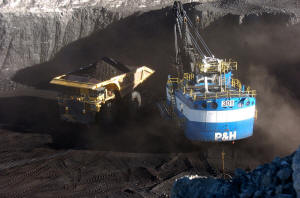Trump is reviving large sales of coal from public lands. Will anyone
want it?
[October 06, 2025] By
MATTHEW BROWN and MEAD GRUVER
BILLINGS, Mont. (AP) — U.S. officials in the coming days are set to hold
the government's biggest coal sales in more than a decade, offering 600
million tons from publicly owned reserves next to strip mines in Montana
and Wyoming.
The sales are a signature piece of President Donald Trump's ambitions
for companies to dig more coal from federal lands and burn it for
electricity. Yet most power plants served by those mines plan to quit
burning coal altogether within 10 years, an Associated Press data
analysis shows.
Three other mines poised for expansions or new leases under Trump also
face declining demand as power plants use less of their coal and in some
cases shut down, according to data from the U.S. Energy Information
Administration and the nonprofit Global Energy Monitor.
Those market realities raise a fundamental question about the Republican
administration's push to revive a heavily polluting industry that long
has been in decline: Who's going to buy all that coal?
The question looms over the administration's enthusiastic embrace of
coal, a leading contributor to climate change. It also shows the
uncertainty inherent in inserting those policies into markets where
energy-producing customers make long-term decisions with massive
implications, not just for their own viability but for the future of the
planet, in an ever-shifting political landscape.

Rushing to approve projects
The upcoming lease sales in Montana and Wyoming are in the Powder River
Basin, home to the most productive U.S. coal fields.
Officials say they will go forward beginning Monday despite the
government shutdown. The administration exempted from furlough those
workers who process fossil fuel permits and leases.
Democratic President Joe Biden last year acted to block future coal
leases in the region, citing their potential to make climate change
worse. Burning the coal from the two leases being sold in coming days
would generate more than 1 billion tons of planet-warming carbon
dioxide, according to a Department of Energy formula.
Trump rejected climate change as a “con job” during a Sept. 23 speech to
the U.N. General Assembly, an assessment that puts him at odds with
scientists. He praised coal as “beautiful" and boasted about the
abundance of U.S. supplies while deriding solar and wind power.
Administration officials said Wednesday that they were canceling $8
billion in grants for clean energy projects in 16 states won by Democrat
Kamala Harris in the 2024 presidential election.
In response to an order from Trump on his first day in office in
January, coal lease sales that had been shelved or stalled were revived
and rushed to approval, with considerations of greenhouse gas emissions
dismissed. Administration officials have advanced coal mine expansions
and lease sales in Utah, North Dakota, Tennessee and Alabama, in
addition to Montana and Wyoming.
Interior Secretary Doug Burgum said Monday that the administration is
opening more than 20,000 square miles (52,000 square kilometers) of
federal lands to mining. That is an area bigger than New Hampshire and
Vermont combined.
The administration also sharply reduced royalty rates for coal from
federal lands, ordered a coal-fired power plant in Michigan to stay open
past planned retirement dates and pledged $625 million to recommission
or modernize coal plants amid growing electricity demand from artificial
intelligence and data centers.
“We're putting American miners back to work,” Burgum said, flanked by
coal miners and Republican politicians. “We've got a demand curve coming
at us in terms of the demand for electricity that is literally going
through the roof.”

Coal demand plummets
The AP's finding that power plants served by mines on public lands are
burning less coal reflects an industrywide decline that began in 2007.
Energy experts and economists were not surprised. They expressed doubt
that coal would ever reclaim dominance in the power sector. Interior
Department officials did not respond to questions about future demand
for coal from public lands.
[to top of second column] |

A haul truck is seen after being loaded with coal by a mechanized
shovel at the Spring Creek mine, in this Nov. 15, 2016 photo, near
Decker, Mont. (AP Photo/Matthew Brown)
 But it will take time for more
electricity from planned natural gas and solar projects to come
online. That means Trump’s actions could give a short-term bump to
coal, said Umed Paliwal, an expert in electricity markets at the
University of California, Berkeley.
“Eventually coal will get pushed out of the market,” Paliwal said.
“The economics will just eat the coal generation over time.”
The coal sales in Montana and Wyoming were requested by Navajo
Nation-owned company. The Navajo Transitional Energy Co. (NTEC) has
been one of the largest industry players since buying several major
mines in the Powder River Basin during a 2019 bankruptcy auction.
Those mines supply 34 power plants in 19 states.
Twenty-one of the plants are scheduled to stop burning coal in the
next decade. They include all five plants using coal from NTEC's
Spring Creek mine in Montana.
In filings with federal officials, the company said the fair market
value of 167 million tons of federal coal next to the Spring Creek
mine was just over $126,000.
That is less than one-tenth of a penny per ton, a fraction of what
coal brought in its heyday. By comparison, the last large-scale
lease sale in the Powder River Basin, also for 167 million tons of
coal, drew a bid of $35 million in 2013. Federal officials rejected
that as too low.
NTEC said the low value was supported by prior government reviews
predicting fewer buyers for coal. The company said taxpayers would
benefit in future years from royalties on any coal mined.
“The market for coal will decline significantly over the next two
decades. There are fewer coal mines expanding their reserves, there
are fewer buyers of thermal coal and there are more regulatory
constraints,” the company said.
In central Wyoming on Wednesday, the government will sell 440
million tons of coal next to NTEC’s Antelope Mine. Just over half of
the 29 power plants served by the mine are scheduled to stop burning
coal by 2035.
Among them is the Rawhide plant in northern Colorado. It is due to
quit coal in 2029 but will keep making electricity with natural gas
and 30 megawatts of solar panels.

Aging plants and optimism
The largest U.S. coal company has offered a more optimistic take on
coal's future. Because new nuclear and gas plants are years away,
Peabody Energy suggested in September that demand for coal in the
U.S. could increase 250 million tons annually — up almost 50% from
current volumes.
Peabody’s projection was based on the premise that existing power
plants can burn more coal. That amount, known as plant capacity,
dropped by about half in recent years.
"U.S. coal is clearly in comeback mode," Peabody's president, James
Grech, said in a recent conference call with analysts. “The U.S. has
more energy in its coal reserves than any nation has in any one
energy source.”
No large coal power plants have come online in the U.S. since 2013.
Most existing plants are 40 years old or older. Money pledged by the
administration to refurbish older plants will not go very far given
that a single boiler component at a plant can cost $25 million to
replace, said Nikhil Kumar with GridLab, an energy consulting group.
That leads back to the question of who will buy the coal.
“I don't see where you get all this coal consumed at remaining
facilities," Kumar said.
___
Gruver reported from Wellington, Colorado. Associated Press writer
Susan Montoya Bryan in Albuquerque, New Mexico, contributed to this
report.
All contents © copyright 2025 Associated Press. All rights reserved |